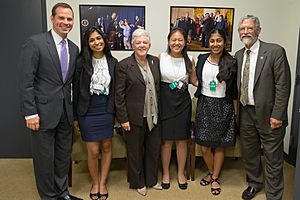John Holdren facts for kids
Quick facts for kids
John Holdren
|
|
|---|---|
 |
|
| Director of the Office of Science and Technology Policy | |
| In office March 19, 2009 – January 20, 2017 |
|
| President | Barack Obama |
| Preceded by | Ted Wackler (Acting) |
| Succeeded by | Ted Wackler (Acting) |
| Personal details | |
| Born | March 1, 1944 Sewickley, Pennsylvania, U.S. |
| Political party | Democratic |
| Education | Massachusetts Institute of Technology (BS, MS) Stanford University (PhD) |
| Awards |
|
| Scientific career | |
| Fields | Physics, Environmental science |
| Institutions | |
| Thesis | Collisionless stability of an inhomogeneous, confined, planar plasma (1970) |
| Doctoral advisor | Oscar Buneman |
| Doctoral students | Kirk R. Smith |
John Paul Holdren, born on March 1, 1944, is an American scientist. He was a top advisor to President Barack Obama on science and technology. He held important jobs like director of the White House Office of Science and Technology Policy. He also co-chaired the President's Council of Advisors on Science and Technology (PCAST).
Before working for the President, Mr. Holdren was a professor at Harvard University. He also led programs focused on science, technology, and how they affect public policy. He was also the director of the Woods Hole Research Center.
Contents
Early Life and Education
John Holdren was born in Sewickley, Pennsylvania. He grew up in San Mateo, California. He studied aeronautics (the science of flight), astronautics (the science of space travel), and plasma physics.
He earned his first degree from the Massachusetts Institute of Technology in 1965. He then received his PhD from Stanford University in 1970. His PhD advisor was Oscar Buneman.
Career Highlights
Mr. Holdren taught at Harvard University for 13 years. He also taught at the University of California, Berkeley for over two decades. His work focused on big topics like global environmental change. He also studied energy technologies and policies. He worked on ways to make nuclear weapons less dangerous.

The Simon–Ehrlich Wager
In 1980, Holdren was part of a famous bet called the Simon–Ehrlich wager. He and two other scientists helped Paul R. Ehrlich make a bet with Julian Simon. They bet that the price of five important metals would be higher in 1990. This bet was about whether Earth's resources would become scarce as the population grew. Ehrlich and Holdren lost the bet because the prices of the metals actually went down by 1990.
Awards and Leadership Roles
In 1981, John Holdren received a MacArthur Fellowship. This award is sometimes called the "genius award." He earned it for working to promote world peace through smart energy use.
From 1987 to 1997, Holdren led the Executive Committee of the Pugwash Conferences on Science and World Affairs. He gave the Nobel Peace Prize acceptance speech for the Pugwash Conferences in 1995. He also chaired a committee on international security for the United States National Academy of Sciences.
From 2002 to 2007, he co-chaired the National Committee on Energy Policy. He was elected President of the American Association for the Advancement of Science (AAAS) for 2006–2007. He then served as the board chairman for AAAS. He also helped start the advisory board for Innovations, a journal about solving global challenges.
In 2000, Holdren became a member of the National Academy of Engineering. This was for his clear explanations of energy, environment, and nuclear issues.
Serving the President
John Holdren was a science advisor to President Bill Clinton from 1994 to 2001. Years later, in December 2008, President Barack Obama chose Holdren to be his science advisor. He also became the director of the Office of Science and Technology Policy. The Senate approved his nomination on March 19, 2009.
Published Works
Early in his career, Holdren was very interested in overpopulation. In 1969, he wrote an article with Paul R. Ehrlich. They argued that if population control measures were not started soon, technology alone would not prevent future problems. In 1977, Paul R. Ehrlich, Anne H. Ehrlich, and Holdren wrote a textbook together called Ecoscience: Population, Resources, Environment.
He also wrote many other books and articles. These include:
- Energy (1971)
- Human Ecology (1973)
- Energy in Transition (1980)
- Earth and the Human Future (1986)
- Strategic Defenses and the Future of the Arms Race (1987)
- Building Global Security Through Cooperation (1990)
- Conversion of Military R&D (1998)
Holdren has written over 200 articles and papers. He has also helped write or edit about 20 books. Some of his more recent works include:
- Science in the White House. Science, May 2009.
- Policy for Energy Technology Innovation. (with others), Brookings Institution Press, 2009.
- The Future of Climate Change Policy: The U.S.'s Last Chance to Lead. Scientific American 2008.
- Convincing the Climate Change Skeptics. The Boston Globe, August 4, 2008.
- Meeting the Climate-Change Challenge. The John H. Chafee Memorial Lecture, National Council for Science and the Environment, January 17, 2008.
Personal Life
John Holdren lives in Falmouth, Massachusetts. He is married to biologist Cheryl E. Holdren. They have two children and five grandchildren.
Affiliations and Awards
- MacArthur Fellow (1981)
- Fellow of the American Academy of Arts and Sciences (1983)
- Fellow of the American Physical Society (1988)
- Member of the National Academy of Sciences (1991)
- Volvo Environment Prize (1993 with Paul Ehrlich)
- Kaul Foundation Award in Science and Environmental Policy (1999)
- Member of the National Academy of Engineering (2000)
- Tyler Prize for Environmental Achievement (2000)
- 7th Annual Heinz Award in Public Policy (2001)
- Member of the American Philosophical Society (2015)
- Lawrence S. Huntington Environmental Prize (2017)
- Public Welfare Medal from National Academy of Sciences (2022)
See also
 In Spanish: John Paul Holdren para niños
In Spanish: John Paul Holdren para niños

